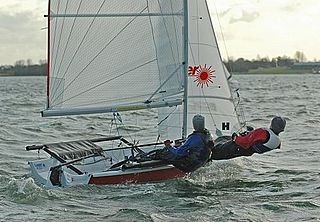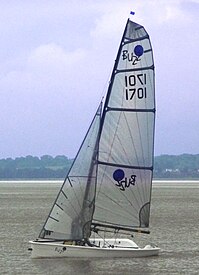The Mirror is a type of popular sailing dinghy with more than 70,000 built.

Dinghy racing is a competitive sport using dinghies, which are small boats which may be rowboats, have an outboard motor, or be sailing dinghies. Dinghy racing has affected aspects of the modern sailing dinghy, including hull design, sail materials and sailplan, and techniques such as planing and trapezing.

The Laser is a class of single-handed, one-design sailing dinghies using a common hull design with three interchangeable rigs of different sail areas, appropriate to a given combination of wind strength and crew weight. Ian Bruce and Bruce Kirby designed the Laser in 1970 with an emphasis on simplicity and performance.

The Wayfarer is a wooden or fibreglass hulled fractional Bermuda rigged sailing dinghy of great versatility; it can be used for short 'day boat' trips, for longer cruises and for racing. Over 11,000 have been produced as of 2016.

The Laser 4000 is a racing dinghy designed by Phil Morrison crewed by two persons. Its one-design weight-equalised system enables physically differing sailors to compete on a level playing field. It is most popular in Europe, particularly the UK, France and Italy.

The 18 ft Skiff is considered the fastest class of sailing skiffs. The class has a long history beginning with races on Sydney Harbour, Australia in 1892 and later in New Zealand. The boat has changed significantly since the early days, bringing in new technology as it became available. Because of the need of strength, agility and skill, the class is considered to be the top level of small boat sailing. Worldwide this boat is called the "18 Foot Skiff". It is the fastest conventional non-foiling monohull on the yardstick rating, with a score of 675, coming only third after the Tornado and Inter 20.

The 12 ft Skiff is a development dinghy class dating back to the early 20th century. It is sailed in Australia and New Zealand. It is 12 ft (3.7 m) in length, hence the name, and is a two-man boat. Both the crew and the helm are able to use the trapeze at the same time. It has an asymmetrical spinnaker and a jib, in addition to the mainsail.

The RS800 is a light-weight sailing dinghy designed by Phil Morrison and manufactured by RS Sailing. The boat is sailed by two people both on trapeze and has a main, jib and spinnaker. The RS800 has a Portsmouth Yardstick number of 799 and a D-PN of 77.0. There is a large racing circuit in the UK, and some European events each year.

The RS200 is a 4m, double handed, hiking, racing dinghy. Designed in 1995 by Phil Morrison and manufactured by RS Sailing, it has a lightweight polyester GRP with Coremat hull construction.

The Laser 3000 is a racing sailing dinghy crewed by two persons with a trapeze for the crew. Launched in 1996, the 3000 was developed from the Laser 2, using the original Frank Bethwaite-designed planing hull combined with a brand new self-draining deck by Derek Clark. Clark also re-designed the rig, using spars and sails from premium proprietary sources and replacing the symmetric spinnaker of the Laser 2 by a larger asymmetrical spinnaker. The gennaker is chute-launched and retrieved using a single halyard line, and is set on a retractable bowsprit. Helm balance and handling were improved using a shorter-footed mainsail with two full-width battens giving a larger roach. A mast with conventional spreaders replaced the now-unusual diamond arrangement of the Laser 2.

The 3000 is a racing sailing dinghy crewed by two persons with a trapeze for the crew. Launched in 1996 as the Laser 3000, the 3000 was developed from the Laser 2, using the original Frank Bethwaite-designed planing hull combined with a new designed self-draining deck by Derek Clark. Clark also re-designed the rig, using spars and sails from premium proprietary sources and replacing the symmetric spinnaker of the Laser 2 by a larger asymmetric spinnaker (gennaker). The gennaker is chute-launched and retrieved using a single halyard line, and is set on a retractable bowsprit. Helm balance and handling were improved using a shorter-footed mainsail with two full-width battens giving a larger roach. A mast with conventional spreaders replaced the now-unusual diamond arrangement of the Laser 2.

The Jacksnipe is a two-man racing sailing dinghy with a single trapeze for the crew and symmetrical spinnaker.
The 2000(formerly the Laser 2000) is a performance sailing dinghy designed by Phil Morrison and currently sold by RS Sailing. It combines a traditional GRP hull and foam sandwich deck moulding with a modern asymmetric rig including a furling jib, reefing mainsail and single line gennaker hoist system.

A trailer sailer is a type of sailboat that has been designed to be easily transported using a boat trailer towed by an automobile. They are generally larger than a sailing dinghy. Trailer sailers include day sailers and small cabin cruisers, suitable for living on.

The Laser Vago is a British/American sailing dinghy that was designed by Jo Richards as a one-design racer and first built in 2005.

The B14 is a two person monohull dinghy, designed by Julian Bethwaite. It is recognised as an international class by the International Sailing Federation. The boat was designed in 1984.

The RS Tera is a one-man monohull dinghy in the RS Sailing range of sailing boats. It is recognised by the International Sailing Federation (ISAF) as an international class, and is a popular boat for beginners and for children to race.
ISO is an International Sailing Federation (ISAF) class of two-person sailing dinghy with a single trapeze and an asymmetric spinnaker. The ISO was designed in 1993 by Ian Howlett and John Caig and manufactured by Reg White Limited of Brightlingsea as part of the "White Formula" range of boats originally marketed by Topper International Ltd and since 2013 by Vantage Sailing Ltd. The boat has a fully battened mainsail, jib and an asymmetric spinnaker.

The RS Aero is a British sailing dinghy that was designed by Jo Richards as a one-design racer and first built in 2014.

The Topper Topaz is a British single-handed or two-handed sailing dinghy that was designed as a beginner and intermediate racer.

















